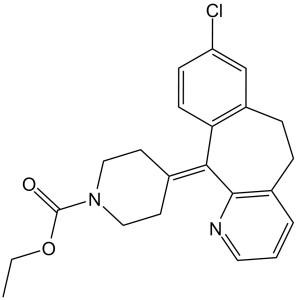This product is for research use only, not for human use. We do not sell to patients.

| Size | Price | Stock |
|---|---|---|
| 1g | $250 | Check With Us |
| 2g | $350 | Check With Us |
| 5g | $550 | Check With Us |
Cat #: V1208 CAS #: 79794-75-5 Purity ≥ 98%
Description: Loratadine (formerly SCH29851; SCH-29851; Claritin; Loratidine; Clarityn; Alavert) is a potent and 2nd-generation histamine H1 receptor antagonist which has been approved for the treatment of allergies such as allergic rhinitis and urticaria. It also acts as a selective inhibitor of B(0)AT2 with IC50 of 4 μM. Loratadine lacks central nervous system depressing effects such as drowsiness. It has been shown to inhibit the release of leukotriene C4 and histamine from rodent mast cells and to inhibit allergic bronchospasm in guinea pigs. Loratadine is a selective inverse peripheral histamine H1-receptor agonist.
Publications Citing InvivoChem Products
Product Promise

- Physicochemical and Storage Information
- Protocol
- Related Biological Data
- Stock Solution Preparation
- Quality Control Documentation
| Molecular Weight (MW) | 382.88 |
|---|---|
| Molecular Formula | C22H23ClN2O2 |
| CAS No. | 79794-75-5 |
| Storage | -20℃ for 3 years in powder formr |
| -80℃ for 2 years in solvent | |
| Solubility In Vitro | DMSO: 17 mg/mL (44.4 mM)r |
| Water: <1 mg/mLr | |
| Ethanol: 77 mg/mL (201.1 mM) | |
| Solubility In Vivo | Chemical Name: ethyl 4-(8-chloro-5,6-dihydrobenzo[1,2]cyclohepta[2,4-b]pyridin-11-ylidene)piperidine-1-carboxylate InChi Key: JCCNYMKQOSZNPW-UHFFFAOYSA-N InChi Code: InChI=1S/C22H23ClN2O2/c1-2-27-22(26)25-12-9-15(10-13-25)20-19-8-7-18(23)14-17(19)6-5-16-4-3-11-24-21(16)20/h3-4,7-8,11,14H,2,5-6,9-10,12-13H2,1H3 SMILES Code: CCOC(=O)N1CCC(=C2C3=C(CCC4=C2N=CC=C4)C=C(C=C3)Cl)CC1 |
| SMILES Code | CCOC(=O)N1CCC(=C2C3=C(CCC4=C2N=CC=C4)C=C(C=C3)Cl)CC1 |
| Synonyms | SCH29851; Loratadine; Claritin; Loratidine; Clarityn; Alavert; Loratadine; Sch 29851; Sch-29851; Sch29851 |
| Protocol | In Vitro | In vitro activity: Loratadine is identified as a selective inhibitor of B(0)AT2 with an IC50 of 4 μM while being less active or inactive against several other members of the SLC6 family. Loratadine concentration-dependently inhibits the release of histamine and LTC4 when preincubating before Der p 1 antigen or anti-Fc epsilon RI challenge in human Fc epsilon RI+ cells. Loratadine (0.1 mM) also inhibits (10-40%) histamine, LTC4, and PGD2 release from purified HLMC (16-68%) activated by anti-Fc epsilon RI. Loratadine causes concentration-dependent inhibition (10-40%) of histamine, tryptase, LTC4, and PGD2 release from purified HSMC (24-72%) immunologically challenged with anti-Fc epsilon RI. Loratadine inhibits significantly IL-6 and IL-8 secretion induced by histamine with a more powerful efficiency of the active metabolite in human umbilical vein endothelial cells (HUVEC). Loratadine blocks hKv1.5 channels in a concentration-, voltage-, time- and use-dependent manner but only at concentrations much higher than therapeutic plasma levels in man in Ltk- cells transfected with the gene encoding hKv1.5 channels. Loratadine inhibits rhinovirus-induced ICAM-1 upregulation in both primary bronchial or transformed (A549) respiratory epithelial cells. Loratadine also inhibits ICAM-1 mRNA induction caused by rhinovirus infection in a dose-dependent manner, and they completely inhibits rhinovirus-induced ICAM-1 promoter activation. Cell Assay: Loratadine(SCH-29851) is a selective inverse peripheral histamine H1-receptor agonist with an IC50 of >32 μM. Loratadine is a non-sedative antihistamine that inhibits histamine-induced activities of IL-6 and IL-8 secretion in endothelial cells. |
|---|
| Solvent volume to be added | Mass (the weight of a compound) | |||
|---|---|---|---|---|
| Mother liquor concentration | 1mg | 5mg | 10mg | 20mg |
| 1mM | 2.6118 mL | 13.0589 mL | 26.1178 mL | 52.2357 mL |
| 5mM | 0.5224 mL | 2.6118 mL | 5.2236 mL | 10.4471 mL |
| 10mM | 0.2612 mL | 1.3059 mL | 2.6118 mL | 5.2236 mL |
| 20mM | 0.1306 mL | 0.6529 mL | 1.3059 mL | 2.6118 mL |
This equation is commonly abbreviated as: C1 V1 = C2 V2
- (1) Please be sure that the solution is clear before the addition of next solvent. Dissolution methods like vortex, ultrasound or warming and heat may be used to aid dissolving.
- (2) Be sure to add the solvent(s) in order.




































